2 Nights in Winery Hotel, Fira
We flew into Fira, the capitol city of Santorini (officially called Thira) from Thessaloniki, a one hour flight and landed before noon. As the sites we were planning to visit were spread across the island, we had decided to rent a car and self-drive. It gave us some flexibility to decide where, when, and how long to spend in each place.
The island of Thira was the site of one of the largest volcanic eruptions in recorded history : the Minoan eruption (or the Thera eruption), which occurred about 3,600 years ago at the height of the Minoan civilization. The eruption left a large caldera surrounded by volcanic ash deposits hundreds of meters deep. You need at least 2 days to visit all the attractions on this page, maybe a day more if you want to visit some of the other volcanic islands in the Santorini archipelago.
- Oia
- Akrotiri Lighthouse
- Red Beach at Akrotiri
- Pyrgos
- Profitis Ilias
- Ancient Thira
- Black Beach at Perissa
- Churches in Thira
If you check out the Santorini Caldera on the map, Oia is located on the northern tip of Santorini, Firá (where we stayed) in the center, and Akrotiri at the Southern tip. The whole island end to end is 30 km driving distance.
Oia is 12 kilometers north of Firá. Akrotiri is about 15 km southwest of Fira. Pyrgos, the former capitol of the island is about 5km south of Fira. You can identify on the map, all the places we visited.

The hotel we were staying in did not have a parking lot, but the receptionist gave us a map of all the parking locations that we could park in, which were all within walking distance. After checking in, we decided to explore Fira on foot, but first we located the restaurant, recommended by our hotel receptionist and had a satisfying lunch.




Sunset in Oia – located on the northwestern end of Santorini, Oia is considered the most picturesque village of Santorini and holds the position of the most visited spot for sunset viewing. We drove to Oia in the evening to find out for ourselves the hype around sunset viewing. It took us some time to find parking and after driving around for 10 min, found a paid parking area ($20). A 20 min uphill walk took us to the Venetian castle ruins of Agios Nikolaos, which apparently is the most popular location from where one can admire the world renowned sunset of Santorini. As it was too crowded at the castle, we walked around and found a less crowded place to watch the sunset. This place we picked also provided a great view of the Aegean sea and the Venetian castle ruins of Agios Nikolaos.




After watching the sunset, we walked to the castle which was now less crowded as people had left the scene. This Venetian castle of Agios Nikolaos is named after a beautiful church carved in a rock, dedicated to Agios Nikolaos. Its existence dates back to the late 15th century and was built in order to serve as an observation point. It was very well fortified with residences inside belonging to the Venetian rulers. After the destructive earthquake of 1956 only a part of its watchtower is left. We spent some time enjoying the view of the caldera, Aegean sea, and the white washed houses in fading light from the castle.
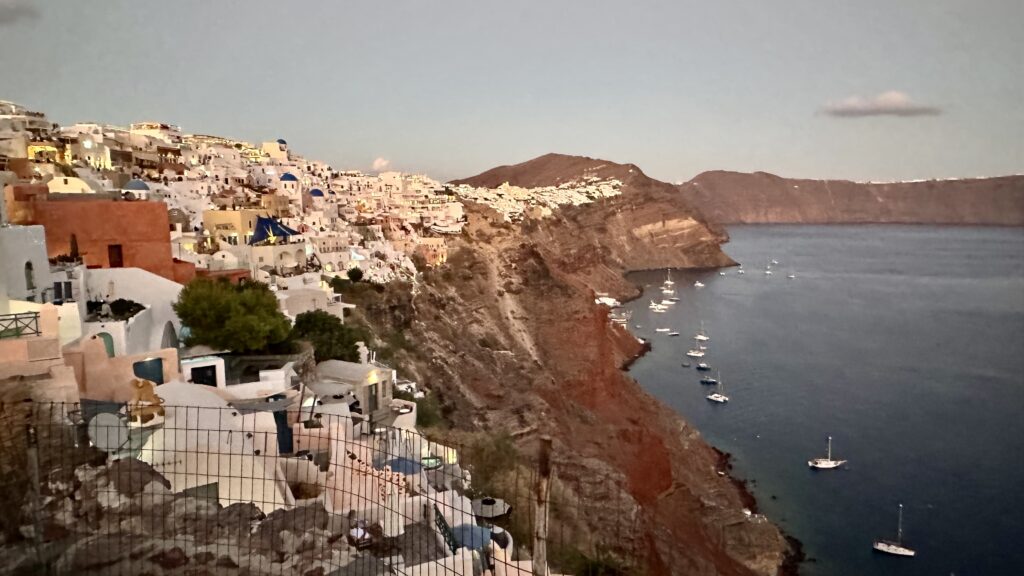

Note : Oia gets quite crowded leading up to the predicted sunset time, and you most likely will have to jockey for position in order to score one of the prime spots. The good news is that as long as you can see the water, whether you are on the donkey trail, at a terrace restaurant, or standing up by castle, you will get a stunning view of the sunset.
Blue Domed churches of Oia – Taking a picture with the famed blue domed churches in the background is at the top of everyone’s list in Oia. We drove back to Oia early the next day morning before the cruise crowd started pouring in. After we found the most photogenic blue domed churches, we had to stand in line for 30 min to take that perfect picture. The Church of Anastasi was built in 1865, and the church of St. Spirydon – 2 years later, in 1867.
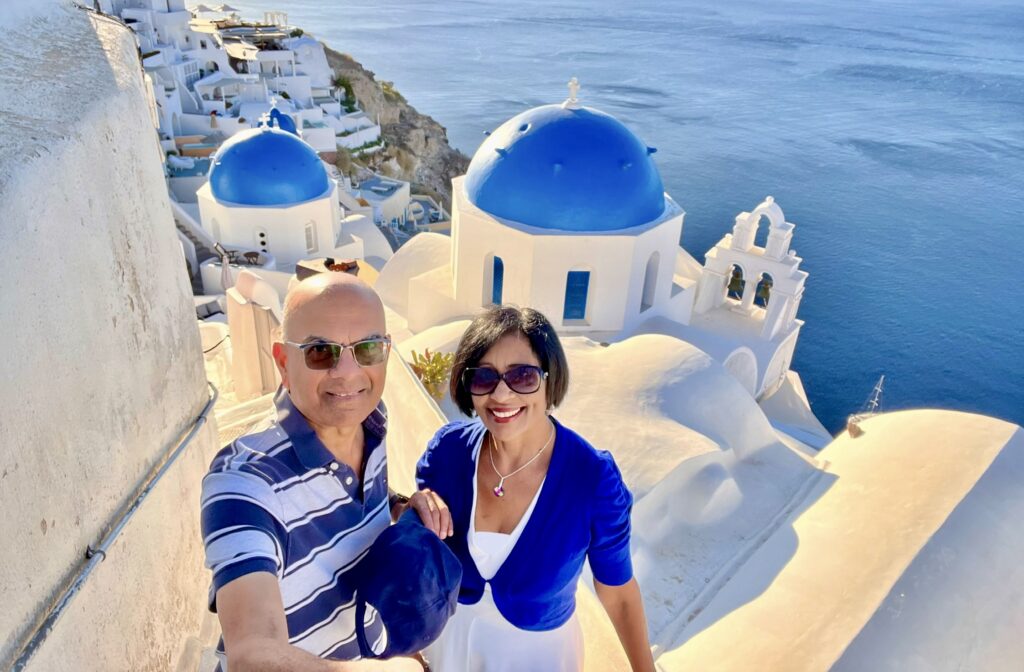
We got some great shots of other blue domed churches as we walked around Oia.




Akrotiri Lighthouse – About 15 km from Fira, we drove to this lighthouse in the morning after breakfast. Built in 1892 and one of the first lighthouses to be built in Greece, it is situated in the lovely and tranquil village of Akrotiri on the edge of a high cliff right above the Aegean Sea. The small building below the lighthouse used to be the house of the warden, who was taking care of it during the first years that it was operating.


You get a gorgeous view of the Caldera from this location. If you are looking for a quite place to enjoy a stunning sunset, this is the place.



Red Beach at Akrotiri – Our next stop was at the red beach. There is a free parking lot from where you have to hike down (or scramble) over rocks to the beach. The blue waters and skies contrast against cliffs of red (actually burgundy) lava rock. Trying to walk barefoot on the beach was a bit painful as the beach is made up of mostly small pebbles.




Pyrgos – This small town located about 8km southeast of Fira was the capital of Santorini until 1800. It is made up of whitewashed Cycladic cottages and provides great panoramic views of both sides of the island. Since 2004 Pyrgos has started to cater to upmarket tourism with the opening of several small, chic restaurants and boutique hotels. We drove to this town after visiting the red beach in Akrotiri (9 km drive). It was nice to walk around this subdued yet charming town which was not swamped with hordes of cruise-ship passengers. We had a relaxed lunch in one of the restaurants on the main plaza.


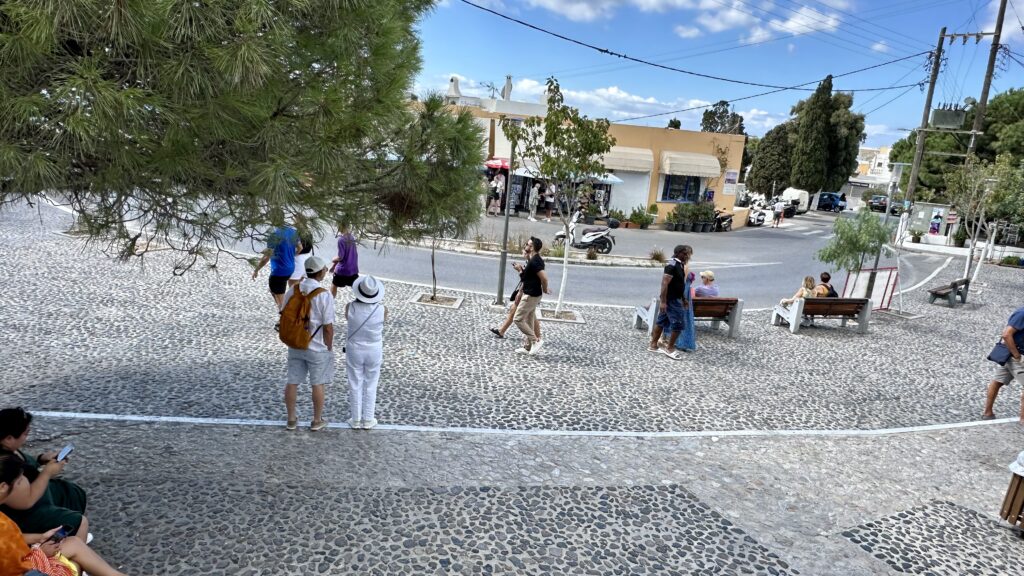

Profitis Ilias – From Pyrgos, a road runs to the summit of Mt. Profítis Ilías (584 meters), Santorini’s highest point, affording panoramic views of the island and out across the sea. You can see this location from many places on the island. The Profitis Ilias Monastery that is located here was built by two monks in 1711, and the site was dedicated to the Biblical prophet Elijah, and it became a center for learning Greek literature and language arts. The small chapel on the site features mosaic artwork in its interior, as well as painted depictions of bishops and other religious figures, stained glass and an intricately carved wooden altar screen.

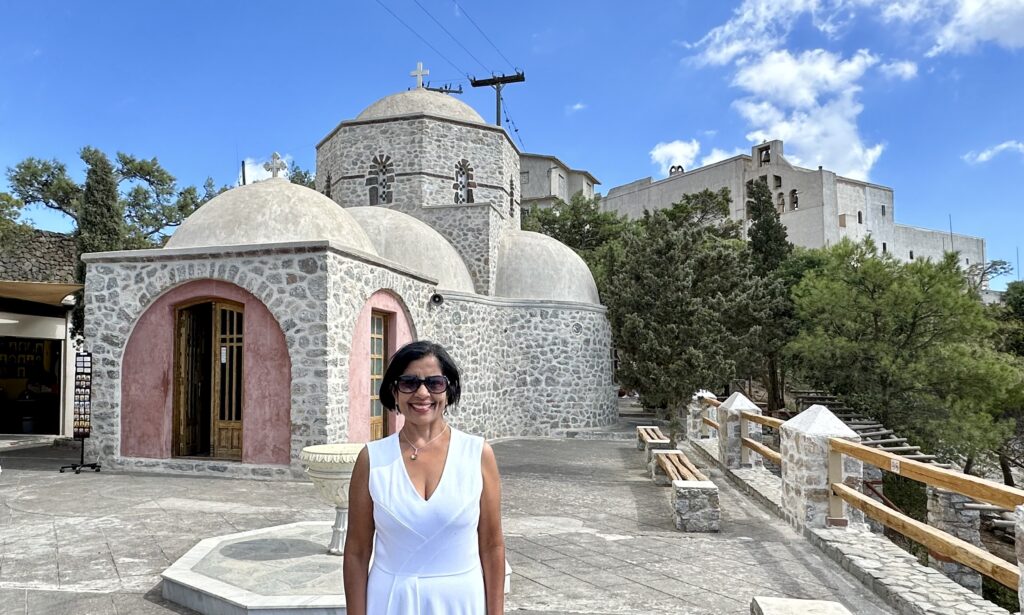


Ancient Thira – 6E per person entry fee – This archaeological sits on the top of a limestone hill called Mesa Vouno. Excavations started here in 1895 and has continued through the1990s and resulted in a more precise understanding of the history of this place. This city was inhabited from 9th century BC until 726 AD. Current belief is a volcano eruption led the city to decline and eventual abandonment.
We drove to this place from Profitis Ilias. The last 12 miles were on a winding road with more than 20 narrow switchbacks. Since we reached the site after 2pm, we only had about 45 minutes to explore the vast ruin with a lot of walking and climbing uphill. We only had time to walk up to the location of ‘Central Section of the city’ before walking back down.
Ancient Thira, The Church of Agios Stefanos (Saint Stephen) – was the first place we came across after walking up a fairly steep incline. In the 6th century AD a basilica had been built here. At some point in time the basilica was destroyed and the Church of Agios Stefanos was built on it’s remains dating back to the 8th or 9th century AD


Ancient Thira, The Temenos of Artemidoros – was founded sometime in mid 3 BC. This temenos, (meaning a temple enclosure or court), was an open air sanctuary chiseled out of rock by a man named Artemidoros. There are carvings here of an eagle, lion, and dolphin representing gods. There is also a carving of Artemidoros himself.

Ancient Thira, The Exedrae – This area had 3 temples in a row dating from 1st or 2nd AD. This area also once had statues on pedestals of the prominent citizens of that time.


It was amazing how expansive this archeological site was and the view from here were just amazing.

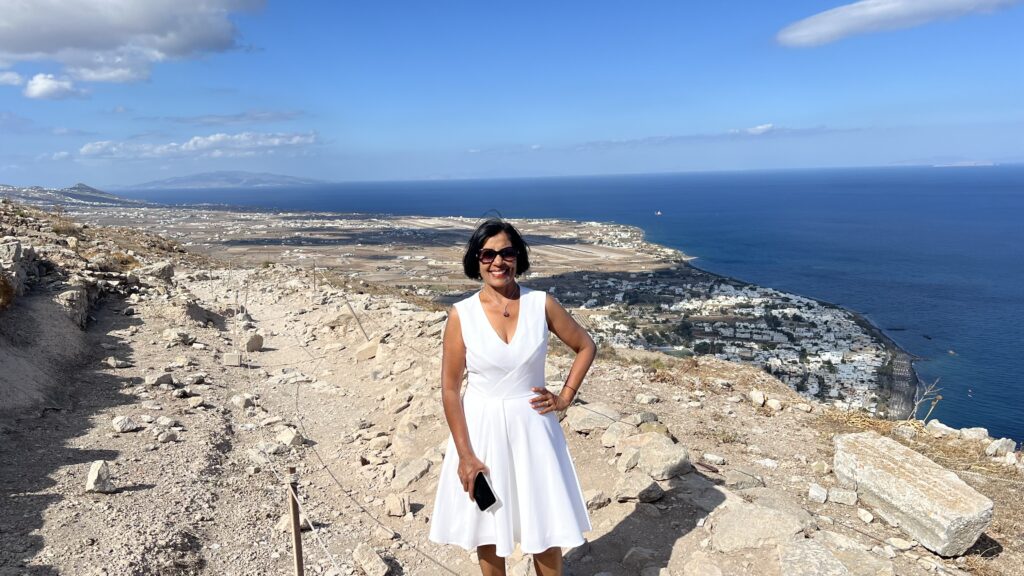

Sunset in Fira – Fira isn’t known for its sunsets, and yet you can still catch some pretty great ones from this end of the island. As we were staying in Fira, getting to a sunset spot was just a hop, skip and jump away. We headed to the top of the donkey trail and found a spot along the low wall. There was barely any crowd and the sunset in Fira was as lovely as in Oia the previous day.


Restaurant with a view – In Fira, there are no shortages of restaurants/bars/cafes with a great view of the Caldera. We found a bar with a great view of Fira and surrounding water body and had a drink.


Santorini Cable Car – The Cable car of Santorini provides visitors with a safe transport from the old port to Fira. The ride lasts about three minutes, and tickets cost €6 for adults and €3 for children. The other option to get to Fira from the port is to walk the 600 steps which would take about 20–30 minutes. The steps are steep, slippery in some places, full of donkey poo and smelly. There is also the option to ride up on the donkeys if you are ok with the smell.



Black Beach – This beach in Perissa is about 12km from Fira with free parking available. Since it was mid morning, there was hardly any crowd and we had a pleasant walk on the six-kilometer-long stretch of fine, black volcanic sand. There are sunbeds and umbrellas to rent, and you can chose to do para sailing.



Why are the houses and churches in Santorini White and Blue – The whitewashed walls and the blue domes represent the colors of the Greek flag. But Santorini buildings weren’t always colored like that. The pretty colours of Greek island homes became mandatory during the military dictatorship of 1967. The regime believed the colours would inspire patriotism and were reflective of Greek nationalism. Eventually, they passed a law in 1974 to mandate the painting of Greek island homes in blue and white. Although these regulations have now been relaxed, the blue and white colours of the Greek Islands have become a huge draw for tourists. Therefore, many islanders continue painting their homes in these colours.
As we drove around Santorini, we came across some gorgeous looking churches. I stopped to take pictures of a few.
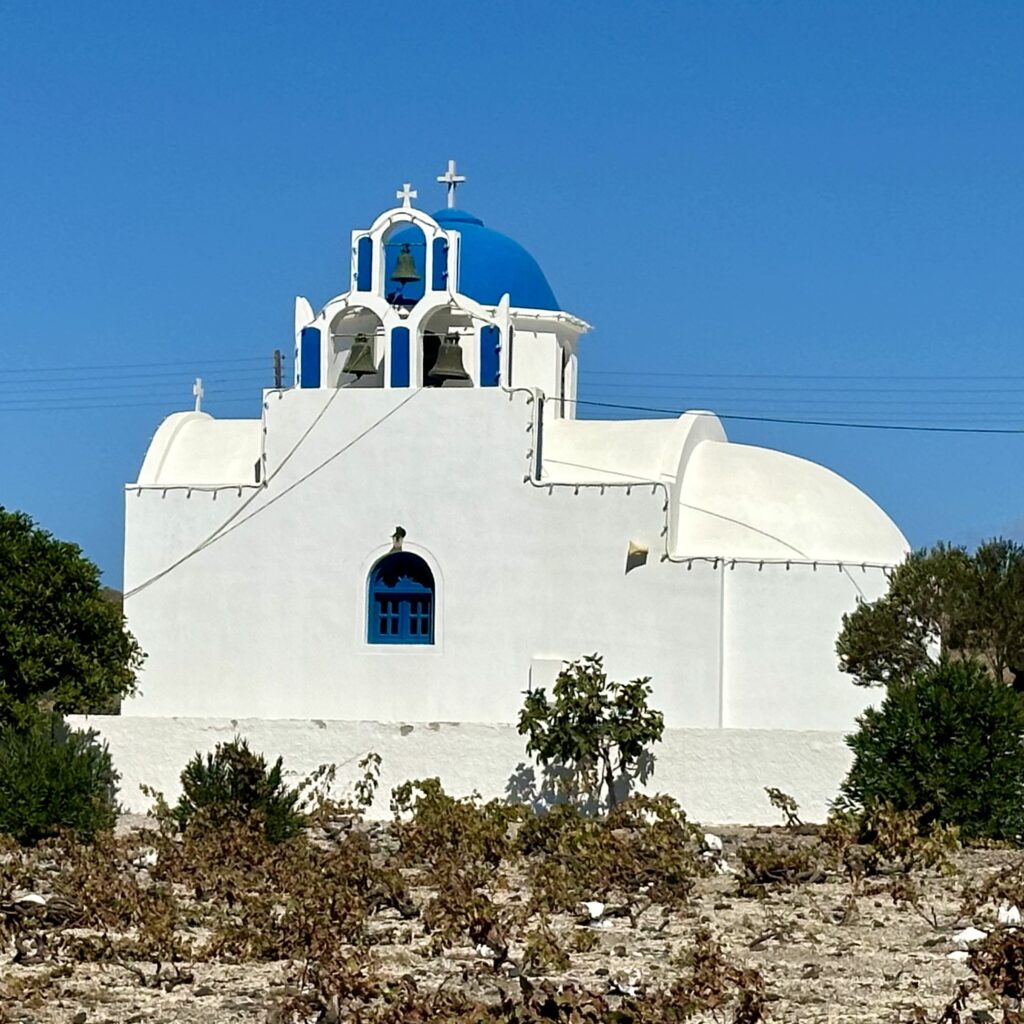




On the last day of our stay in Santorini, after visiting the black beach, we returned the rented car at 2pm. Our Ferry to Crete was at 4:15pm and the rental car company dropped us off at the port.
The reason for picking Santorini as one of the 2 islands we visited was because it has something to offer for every visitor:
- This place is a photographer’s paradise with beautiful sunsets, breathtaking caldera, and striking architecture set against the backdrop of Aegean sea
- For the gastronomes, Santorini offers a vibrant dining scene with a mix of traditional Greek cuisine and high end restaurants, many of which boast amazing views of the caldera
- For history buffs, you have archaeological site in Ancient Thira and archaeological artifacts at Akrotiri
- For beach lovers, there are a ton of volcanic beaches